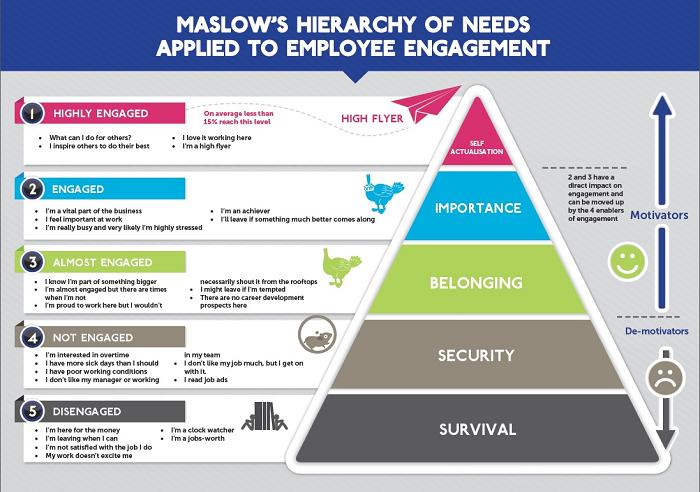Employee engagement is a term used in organizations to describe the commitment of employees with the “heart and soul” of the company. Employees engagement can range from the highly engaged (where they believe its purpose and lives out its values) to the disengaged (where they drag their foot through the door everyday).
This presents a problem to managers and HR professionals all over the world. “How do you keep employees engaged?”
What’s the Fuss About Employee Engagement
Employee engagement can be defined as “the bond employees have with their organization.” What makes this important for organizations is “when employees really care about the business, they are more likely to go the extra mile.”
Studies have shown that the more engaged the workforce is, the better its return on “customer retention and consequently sales performance.”
Where Old School Meets New School: Maslow’s Hierarchy of Needs Applied to Employee Engagement

Breaking down the graphic to its different components, there are two areas employees fall under:
- Motivators
- Demotivators
Here, you’ll also notice that there are five (5) types or levels of engagement that are directly associated with each hierarchy of need. From best to worst, they are as follows:
- Highly engaged
- Engaged
- Almost engaged
- Not engaged
- Disengaged
Disclaimer: This image does not, in any way, suggest that you need to fulfill each level in the hierarchy the same way the original hierarchy of needs does. It is just a way depict where an employee’s engagement falls under that particular moment.
Two Areas of Employee Engagement
What this mean is an employee either falls either on the positive (motivator) or the negative (de-motivator) side of engagement. Of course, you’d naturally want to be on the motivation side.
But what do the two actually mean?
On a high level, when you are focusing your efforts on the bottom two levels (security and survival), you are dealing with demotivating factors; on the other hand, if you focus on the top three levels (belonging, importance, and self-actualization), you are motivating your team.
Five Levels of Employee Engagement
The five levels of employee engagement allow you to visualize where each of your employees stand. In the image, there are statements that they tell themselves secretly that place them at that level.
- Highly engaged
- “What can I do for others?”
- “I love working here.”
- Engaged
- “I feel important at work”
- “I’m really busy and very likely I’m highly stressed”
- Almost engaged
- “I’m proud to work here but I wouldn’t necessarily shout it from the rooftops”
- “I might leave if I’m tempted”
- Not engaged
- “I don’t like my manager or working in my team”
- “I don’t like my job much, but I get on with it.”
- Disengaged
- “I’m leaving when I can”
- “I’m a clock watcher”
The more important question you are probably thinking now is, “how do you move them up a level” or to the point of being highly engaged?
